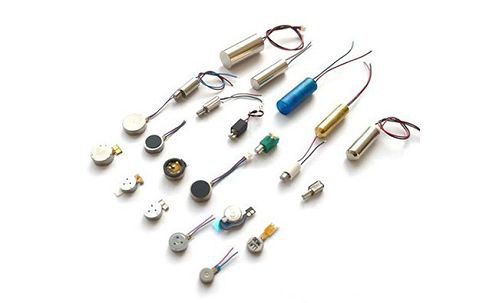Step-by-Step Guide to Measuring Vibration Motor Speed

You can measure vibration motor speed using tools like accelerometers or eddy-current sensors. These instruments help you accurately measure the vibration frequency and RPM to effectively measure vibration motor speed. Obtaining precise measurements is crucial for early detection of issues and maintaining optimal motor performance. To achieve the best results when you measure vibration motor speed, it’s important to mount the sensor correctly. The table below illustrates how different mounting methods affect accuracy and bandwidth:
Mounting Method | Impact on Accuracy and Bandwidth |
|---|---|
Stud (screw) | Best method; ensures sensor stability and provides the most accurate measurements. |
Adhesive tape/beeswax | Effective but less heat resistant, which can affect measurement reliability. |
Magnet | Suitable when used on a magnetic surface, offering good accuracy. |
Hand-held | Quick setup but lower accuracy and reduced bandwidth compared to fixed mounts. |
Key Takeaways
Place accelerometers or other sensors close to the motor bearings. This helps you get correct vibration speed readings.
Gather vibration data in three ways: side to side, up and down, and along the shaft. This helps you see how the motor moves and find problems early.
Use FFT to study vibration frequency. This shows the motor speed and helps you find issues like imbalance or misalignment.
Make sure your tools are set up right. Keep the testing area the same each time. This gives you good and repeatable vibration results.
You can use smartphone apps for fast checks. But for exact results, use special sensors and the same setup every time.
Measure Vibration Motor Speed
Tools and Devices
To measure vibration motor speed, you need special tools. Many people use accelerometers because they are simple and work well. Accelerometers turn vibration into electrical signals. There are two main kinds: piezoelectric and IEPE accelerometers. These sensors help you get good data for your vibration measurement system.
You can also use other devices, like handheld vibration meters or portable vibration testers. These tools let you check vibration fast and often have FFT analysis. Vibration analyzers give you more details and help you find problems early. For constant checks, vibration monitoring systems use wireless sensors to get real-time data.
Here is a table that lists the main tools and what they do:
Tool Type | Application/Use Case | Typical Specifications and Features |
|---|---|---|
Accelerometers | Analyze machine vibrations | Piezoelectric or IEPE sensors; measure acceleration; essential for vibration measurement |
Handheld Vibration Meters | Quick vibration measurement and diagnosis | Measure displacement, velocity, acceleration; FFT analysis; portable; user-friendly |
Portable Vibration Testers | On-the-go diagnostics in manufacturing environments | Measure frequency, displacement, acceleration; store data for trend analysis; predictive maintenance support |
Vibration Analyzers | In-depth vibration data analysis and fault diagnosis | High-precision FFT analysis; store and analyze data; used for predictive maintenance |
Vibration Monitoring Systems | Continuous real-time monitoring of machine health | Wireless sensors; real-time data collection; predictive maintenance; detect developing and chronic problems |
Tip: Accelerometers are the most used tool for measuring vibration motor speed. They give you both low and high-frequency data, so you can spot problems early.
When setting up your vibration measurement system, look for FFT analysis and wireless features. These help you get quick results and make fast choices.
Sensor Placement
Putting the sensor in the right place is important for good results when you measure vibration motor speed. Place the sensor close to the bearings. The bearing housing or support feels the forces from the moving parts of the vibration motor. This spot gives you the best signal for your vibration measurement system.
Follow these steps for the best sensor spot:
Put the sensor on the bearing housing or support. This place gives you the clearest signal from the vibration motor.
If you can, measure at the shaft and bearing assembly. You can also use the end shield or motor frame, but the bearing area is best.
Take two radial measurements at each bearing—one up and one sideways. Also, take an axial measurement near the shaft.
Do not put sensors on thin or weak parts like end bells or fan covers. These parts can change your readings.
If you cannot put the sensor on the bearing housing, use the end shield. Make sure the sensor is at a right angle to the shaft centerline.
Always follow the maker’s rules for sensor placement. Wrong placement can make your measurements less reliable.
Where you put the sensor changes the strength and quality of the vibration signal. The best spot is not always the closest to the problem. You want the highest vibration response and a good signal-to-noise ratio. This helps you find faults early and keep your vibration motor working well.
Note: The pressure of the sensor tip on the bearing’s outer ring and its angle to the spindle axis can change your results. Make sure the sensor is steady and in the right spot for the best data.
By using the right tools and putting your sensors in the best place, you can measure vibration motor speed well and keep your machines working their best.
Measuring the Vibration
Data Collection Steps
To measure vibration, you need to follow steps. This helps you get good and repeatable results from your vibration measurement system. Here are some things you should do:
Pick a sampling rate much higher than the highest frequency you want to measure. This helps you catch all important vibration signals.
Always sample at least twice the highest frequency you see. This stops errors called aliasing.
Put your sensor close to the bearings that hold the shaft. Do not use weak spots like the motor cowling. Strong supports, like motor fins, work best.
Collect data in three ways: horizontal, vertical, and axial. This gives you a full view of the vibration motor’s movement.
Mark where you put sensors with steel tags or use fixed accelerometers. This makes sure you always collect data from the same spot.
Be safe. Make sure you can reach the collection points without touching moving parts or getting stuck in the machine.
Tip: Use stud-mounted sensors and fixed pads to keep your measurements the same. Bar codes and fixed setups help you put sensors in the right spot every time, no matter who does the job.
Recording Vibration Frequency
To record vibration frequency, you need the right tools and ways. Use sensors like accelerometers or laser Doppler vibrometers. Put them on a clean, flat spot near the bearings. This setup gives you the best data.
Vibration signals in the time domain can look messy. You cannot always tell what is happening by looking at the raw data. To fix this, use Fast Fourier Transform (FFT) analysis. FFT changes the data into a spectrum. The spectrum shows you the exact frequencies and their strengths. You can find problems like imbalance or misalignment.
Data logging devices make your work easier. They collect vibration data at high rates and store it safely. Pick a data logger that fits your needs. Make sure it has many channels and can filter data. Check and calibrate your devices often to keep your results correct.
Note: Watching your data all the time helps you find changes in the vibration motor early. This keeps your equipment working well.
Analyzing Results

Calculating Motor Speed
You can figure out motor speed with vibration frequency data. First, look for the main frequency peak in your vibration spectrum. This peak tells you how many times the shaft spins each second. Use this formula:
RPM = Frequency (Hz) × 60
This formula changes hertz into revolutions per minute. For example, a peak at 30 Hz means the motor runs at 1,800 RPM. If you use a Variable Frequency Drive, adjust the rated speed by the ratio of measured frequency to the normal line frequency. Knowing the motor’s pole and slot setup helps you read the vibration peaks better. You can also use velocity spectra to see the main frequency more clearly. Always look for harmonics and sidebands to check your results. Some engineers use strobe lights to match the flashes to the shaft speed and check their math.
Tip: Vibration frequency and RPM are closely linked. This helps you measure vibration motor speed very accurately. Power Spectral Density analysis can help you find the main frequency peaks.
Interpreting Frequency Peaks
When you check the frequency spectrum, you will notice several peaks. Each peak gives you clues about how the motor is working. The biggest peak usually matches the motor’s running speed. Harmonics, which are multiples of the main frequency, can show problems like misalignment or loose parts. Peaks at fan blade passing frequencies may mean there are airflow problems or blade damage. Rotor bar-passing frequencies often point to rotor bar problems.
Here is a table that explains what different frequency peaks mean:
Frequency Peak Type | What It Means |
|---|---|
Fan blade passing frequency | Airflow forces; blade damage or resonance |
Rotor bar-passing frequency | Rotor bar problems; higher amplitude and sidebands |
Electrical frequency related peaks | Electrical problems; voltage unbalance or bent shaft |
Motor running speed (rpm) | Resonance or loose structure |
High-frequency peaks (>30,000 cpm) | Rotor bar or slot-passing problems |
Axis-specific vibration readings | Vertical: base problems; Horizontal: unbalance; Axial: misalignment |
You can use frequency spectrum analysis to find faults. Look for sidebands and harmonics to spot problems like bearing defects, unbalance, or misalignment. Finding problems early helps you plan repairs and stop breakdowns. If you see bigger peaks or new ones, check for new problems starting.
Troubleshooting
Common Pitfalls
When you measure vibration motor speed, you might face some problems. Knowing these problems helps you avoid mistakes and get better results.
If you use bad or uncalibrated tools, your data can be wrong. Always pick good, calibrated accelerometers or vibration meters.
Things like heat, dust, and uneven loads can change your readings. These things may cause imbalance or mess up the vibration signals.
Small changes in motor parts or wear can affect your measurements. Even tiny changes in part size or shape can move vibration frequencies.
Resonance happens when the motor speed matches the machine’s natural frequency. This can make vibrations much stronger and may hurt the motor.
Not knowing the difference between acceleration, velocity, and displacement can make you read the data wrong. Each one tells you something different about the motor’s health.
Tip: Keep your motor safe from dust and heat. Use covers and pick materials that can handle tough places. Check your tools often and keep them calibrated.
Ensuring Accurate Readings
You can make your measurements better by following some steps:
Write down the real motor speed each time you test. Do not just use the nameplate speed, because it might not match the real speed.
Collect data from more than one spot and direction. Measure in horizontal, vertical, and axial ways for a full picture.
Learn about your motor’s mechanical and electrical parts. This helps you know what the vibration data means.
Use equipment with the right frequency range and sampling rate. Make sure your sensors and data loggers fit your motor’s needs.
Control the testing area. Keep temperature and humidity steady, and stop outside vibrations with shock absorbers or strong mounts.
Aspect | Why It Matters |
|---|---|
Calibration | Keeps your tools working right and reliable. |
Environmental Control | Cuts down errors from temperature, humidity, and outside vibrations. |
Proper Mounting | Stops false readings from loose or weak sensor spots. |
Note: Checking calibration and controlling the environment helps you find problems early and keeps your vibration motor working well.
Measuring Vibration Strength
Quick Assessment Methods
There are a few easy ways to check how strong a motor vibrates. These steps give you fast answers and do not need hard setups:
Power the motor with something simple. You can use a battery or a microcontroller like Arduino. Send a short pulse, about 100ms, to the motor. This keeps your data clear and stops overload.
Put an accelerometer, like the MMA7361, right on the motor. Place both the motor and sensor on a known weight, like a 100g sled. This setup helps the vibration move well and gives you the same results each time.
Keep the test setup away from other surfaces. Use foam or hang it up to block outside vibrations from changing your readings.
Save the vibration data. Connect the accelerometer to your Arduino. Send the readings to your computer. Use software like Processing to save the data as a CSV file for later.
Tip: Always use the same setup every time you test. This helps you compare results and see if the vibration strength changes.
You can pick from different devices to measure vibration strength. Here is a table to compare them:
Device | Accuracy & Sample Rate | Ease of Use | Cost | Notes |
|---|---|---|---|---|
TI's SensorTag | Low sample rate, less accurate | Very easy, wireless | ~$30 | Good for simple checks, not for precise measurement |
Extech VB300 | Moderate sample rate, limited quality | Affordable, real-time data | ~$300 | Good for basic frequency checks, some quality concerns |
Fluke 805 | High sample rate, real-time analysis | Very simple, press to use | ~$2,000 | Great for quick checks, limited data storage |
Using Smartphone Apps
Smartphone apps are a quick and easy way to measure vibration. Many phones have built-in accelerometers that can track vibration strength. Studies show these apps can be as good as special vibration tools in many cases. You can use your phone to check both low and high vibration levels.
Study / Author(s) | Focus | Key Findings | Accuracy Compared to Dedicated Devices |
|---|---|---|---|
Feng et al. | Structural vibration monitoring | Good agreement with reference sensors | Comparable for structural responses |
Mourcou et al. | Sensor accuracy vs. robot arm | Results match industrial sensors | Comparable to industrial units |
Kos, Tomažič, Umek | Variability among smartphones | High variability, calibration needed | Calibration improves accuracy |
Smartphone apps have many good points. They are small, easy to use, and cheap. You can carry your phone anywhere and check vibration right away. Some apps even show real-time graphs and let you export data. But phone sensors are not as sensitive as industrial accelerometers. They work best for simple checks, not for very detailed measurements. Calibration makes them more accurate.
Note: For the best results, use the same phone and app each time. If you need very exact data, use an external sensor with your phone.
You can find out vibration motor speed by using simple steps. First, use a PWM signal or battery to run the motor. Next, put the motor and accelerometer on a test sled. Then, use a microcontroller and software to collect vibration data. Setting things up the right way helps you get good results. Careful data checks make your answers more correct. The best sensors and methods help you notice problems early. If you want to learn more, try advanced analyzers, online monitoring, or read technical articles to get better at this.
FAQ
How do you know if your vibration motor speed measurement is accurate?
Check your sensor calibration before each test. Compare your results with the motor’s rated speed. Use the same sensor placement every time. If you see big differences, repeat the test.
What should you do if your vibration readings keep changing?
Make sure your sensor is tight and in the right spot. Keep the area clean and free from dust. Try to measure at the same time of day. If readings still change, check for loose parts on the motor.
Can you use a smartphone to measure vibration motor speed?
Yes, you can use a smartphone with a vibration app. Place your phone firmly on the motor. For best results, use the same phone and app each time. Calibrate your phone if possible.
Why does sensor placement matter so much?
Sensor placement affects the strength and clarity of your readings. Place the sensor near the bearings or on a solid part of the motor. Avoid thin covers or loose parts. Good placement helps you find problems early.
What is the easiest way to record vibration data?
Use a handheld vibration meter or a smartphone app. Press the device firmly against the motor. Save the data to your phone or computer. Many apps let you export results as a CSV file for later review.
See Also
Effective Techniques For Diagnosing And Fixing Motor Vibrations
Simple Five-Step Guide To Mastering Arduino Vibration Motors
Comprehensive Handbook For Accurate Vibration Measurement Techniques
Clarifying Differences Between Vibration And Frequency For Motors
Top Ten Strategies To Reduce Noise And Vibration In Small Motors
Get Custom Micro DC Motors from
INEED Motors!
Leading Brand in Vibration Motor Manufacturing Industry
